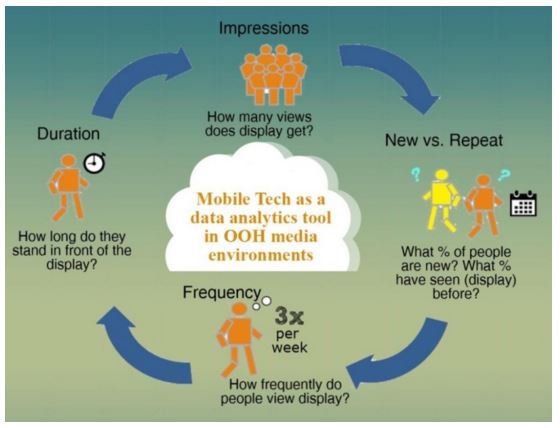
The out of home (OOH) media industry, no longer defined by painted billboards or vinyl, is taking dramatic steps toward delivering a more powerful and cost-effective media platform.
Several OOH media operators have recently developed and announced the launch of new products that, coupled with data and analytics platforms, will provide information that extends far beyond a simple measurement of how many people are seeing their billboards and screens.
These enhanced products inform advertisers about who their audience is, where they go and what they buy – thereby leveling the playing field with other media channels, including online. By leveraging a range of data sources, including mobile, advertisers now have the analytical tools that are currently employed by other media channels.
Ultimately, operators now have the power to reach an exact demographic while these consumers are on the go and in “purchase mode.” In the past couples of years, most large out of home companies started using geolocation technologies to identify their audience and display targeted advertising and content.
These new targeting capabilities significantly improve the effectiveness of OOH campaigns. Inevitably, driven by the satisfaction of the advertisers who tried such mobile-enabled campaigns, the dollars that were previously allocated to other media channels will migrate to out of home.
Access to Real–World Data Gives OOH a Competitive Edge
The emergence of an interconnected ecosystem of out of home media empowered by big data has enormous economic potential and provides advertisers with metrics that were not available in OOH before.
By using mobile-derived and location-based data, advertisers obtain the attribution analytics necessary to measure the true impact of their campaigns on their target segments. This allows marketers to better understand the demographic profiles of consumers passing by their media.
By comparing data from audiences exposed to advertisements on company-owned media against control groups, marketers are able to fully realize the impact and ROI of out of home advertising.
Hard data supporting the substantial ROI of out of home advertising (particularly on a structure-by-structure basis) helps justify the rates that advertisers can command, thus giving operators the ability to more precisely and accurately value their products.
OOH Media Not Subject to Ad Blocking and Online Ad Fraud
The OOH industry is also immune to the ad-blocking movement that has plagued other media channels. Increasing popularity of products like DVR, online ad-blockers and ad-free subscription services has taken its toll on TV and online advertisers.
The physical presence of OOH media structures not only allows its content and advertising to reach target audiences with greater certainty, but also provides the industry with fraud-free impression metrics. There is no valid way to quantify the number of online and mobile advertisements that are actually viewed by human eyes, leading to distorted impression figures and uncertainty surrounding their true reach and effectiveness.
The Door is Open to Unprecedented Re-targeting Opportunities
When it comes to using OOH media as a gateway to re-targeting, these technologies and tools are only the tip of the iceberg. Contextually relevant out of home media content – in connection with geolocation technology and consumer behavior data – provides a unique opportunity to re-target viewers with behaviorally-triggered mobile communications in a variety of settings, from billboards to retail stores to restaurants to supermarkets.
Future ad tech will carefully hone in on where you have been, where you are and what you may do next, to develop consumer patterns in the form of a predictive algorithm. There are multiple examples of OOH companies today using real time metrics and other technology along with digital signage and/or a display network that can adapt content based on gender and age.
Re-targeting will allow marketers to anticipate customer needs before such needs are even expressed. By understanding the needs and movements of an audience, mobile content can be optimized and delivered at a precise time and place, resulting in more effective and efficient advertising.
OOH media in a mobile world gets more interesting by the day and, in our opinion, it’s more powerful than all other media channels given its reach and proximity on the path to purchase.
Published: March 15, 2016